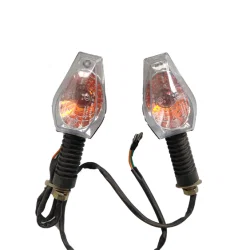Here are the main types and functions of motorcycle lights and indicators
2024-01-09
Motorcycle lights and indicators are crucial components for rider safety and visibility on the road. Here are the main types and functions of motorcycle lights and indicators:
1. Headlights:
- Low Beam and High Beam: Motorcycles are equipped with headlights that have both low and high beam settings. Low beams are used for normal nighttime riding, while high beams provide enhanced visibility for the rider, especially on poorly lit roads.
2. Tail Lights:
- The tail light is positioned at the rear of the motorcycle and is always illuminated when the motorcycle is running. It improves the visibility of the motorcycle to vehicles approaching from behind.
3. Brake Lights:
- Activated when the rider applies the brakes, brake lights signal to other road users that the motorcycle is slowing down or coming to a stop. This is a critical safety feature to prevent rear-end collisions.
4. Turn Signals/Indicators:
- Turn signals or indicators are lights on the front and rear of the motorcycle that flash to signal the rider's intention to turn or change lanes. Proper use of turn signals is essential for safe maneuvering in traffic.
5. Hazard Lights:
- Some motorcycles have hazard lights that can be activated to signal a temporary stop or emergency situation. Hazard lights flash simultaneously on both sides of the motorcycle.
6. Running Lights:
- Running lights are often integrated into the motorcycle's design, providing additional visibility even when the headlights are not in use. They enhance the motorcycle's presence on the road.
7. License Plate Light:
- A small light illuminating the license plate, helping maintain legal compliance and enhancing visibility to law enforcement and other road users.
8. Auxiliary/Accessory Lights:
- Riders may add additional lights, such as spotlights or LED strips, to enhance visibility or aesthetics. These lights are often used to increase visibility in specific conditions.
It's crucial for motorcyclists to regularly check and maintain their lights and indicators to ensure they are in proper working condition. Burnt-out bulbs or malfunctioning electrical components can compromise safety on the road. Additionally, it's essential to use lights and indicators according to traffic laws and regulations to promote safe riding practices.



